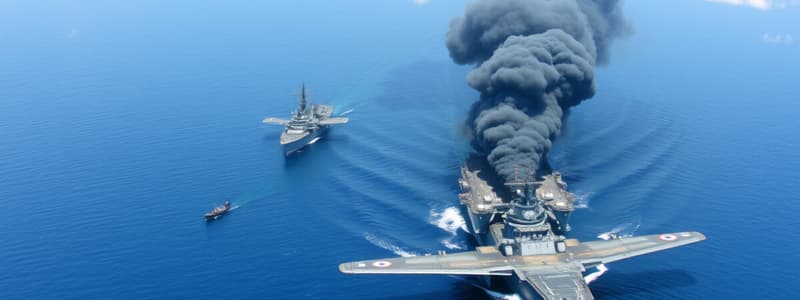Podcast
Questions and Answers
What primarily motivated U.S. concerns about Japanese actions in the 1930s?
What primarily motivated U.S. concerns about Japanese actions in the 1930s?
- Japan's alliance with Germany
- Japanese expansionism in Asia (correct)
- Japan's occupation of Australia
- The establishment of the Axis Powers
What was one objective of the attack on Pearl Harbor?
What was one objective of the attack on Pearl Harbor?
- To gain control of Pacific trade routes
- To weaken the Soviet Union's influence in the Pacific
- To establish a Japanese colony in Hawaii
- To incapacitate the U.S. Pacific Fleet (correct)
Who was a key planner behind the attack on Pearl Harbor?
Who was a key planner behind the attack on Pearl Harbor?
- Admiral Chester W. Nimitz
- Admiral Isoroku Yamamoto (correct)
- Prime Minister Hideki Tojo
- General Douglas MacArthur
What did the U.S. imposes on Japan that contributed to increasing tensions?
What did the U.S. imposes on Japan that contributed to increasing tensions?
What was the immediate outcome of the Pearl Harbor attack?
What was the immediate outcome of the Pearl Harbor attack?
What significant change occurred in U.S. foreign policy following Pearl Harbor?
What significant change occurred in U.S. foreign policy following Pearl Harbor?
At what time did the attack on Pearl Harbor begin?
At what time did the attack on Pearl Harbor begin?
What long-term effect did the Pearl Harbor attack have on the U.S. economy?
What long-term effect did the Pearl Harbor attack have on the U.S. economy?
Flashcards are hidden until you start studying
Study Notes
Historical Background of the Pearl Harbor Bombing
-
Pre-War Tensions:
- Rising tensions between the United States and Japan in the 1930s due to Japanese expansionism in Asia.
- Japan's invasion of China (1937) and occupation of French Indochina heightened U.S. concerns.
-
U.S. Relations with Japan:
- The U.S. imposed economic sanctions and trade embargoes on Japan, particularly targeting oil and steel exports.
- Diplomatic negotiations failed, leading to increased Japanese militarization and planning for war.
-
Pearl Harbor as a Strategic Target:
- Pearl Harbor, located in Hawaii, was the primary U.S. naval base in the Pacific.
- Its destruction would incapacitate the U.S. Pacific Fleet and allow Japan to expand its territory unchallenged.
-
Japanese Military Strategy:
- Planning for the attack began in early 1941, spearheaded by Admiral Isoroku Yamamoto and other military leaders.
- The objective was to deliver a surprise blow to the U.S. naval forces and secure Japanese dominance in the Pacific.
-
Attack Date:
- The bombing of Pearl Harbor occurred on December 7, 1941.
- Coordinated aerial assault began at 7:48 AM local time.
-
Outcome:
- The attack resulted in significant U.S. losses: 2,403 Americans killed, 1,178 wounded, and substantial damage to ships and aircraft.
- Followed by the U.S. formal entry into World War II, declaring war on Japan on December 8, 1941.
-
Long-term Consequences:
- Shifted U.S. foreign policy from isolationism to active engagement in World War II.
- Led to increased military mobilization and wartime production in the U.S.
-
Historical Significance:
- The attack on Pearl Harbor is remembered as a pivotal moment in U.S. history, marking the start of its full-scale involvement in World War II.
Historical Background of the Pearl Harbor Bombing
- Pre-World War II tensions grew between the U.S. and Japan in the 1930s due to Japanese territorial expansion in Asia.
- Japan's invasion of China in 1937 and the occupation of French Indochina raised U.S. alarm regarding Japanese ambitions.
- Economic sanctions and trade embargoes were imposed by the U.S. on Japan, primarily affecting oil and steel supplies.
- Failed diplomatic efforts escalated Japanese militarization and preparations for war against the U.S.
- Pearl Harbor served as the main U.S. naval base in the Pacific, making it a strategic target for Japan to incapacitate the U.S. Navy.
- The attack was orchestrated by Admiral Isoroku Yamamoto and Japanese military leaders, aiming for a decisive first strike against U.S. naval forces.
- The bombing took place on December 7, 1941, with a coordinated assault beginning at 7:48 AM local time.
- U.S. casualties included 2,403 deaths, 1,178 injuries, along with extensive damage to naval ships and aircraft.
- The immediate aftermath led to the U.S. declaring war on Japan on December 8, 1941, marking its entry into World War II.
- This attack shifted U.S. foreign policy away from isolationism towards active military engagement.
- Pearl Harbor's bombing necessitated increased U.S. military mobilization and wartime industrial output.
- The event is historically significant as it represents the turning point for U.S. involvement in global conflict during World War II.
Studying That Suits You
Use AI to generate personalized quizzes and flashcards to suit your learning preferences.




